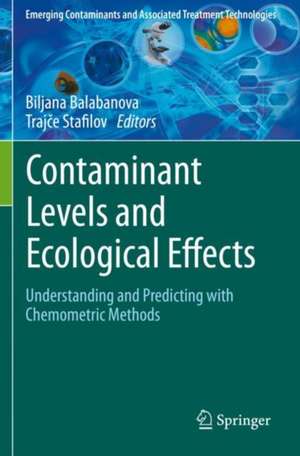Contaminant Levels and Ecological Effects: Understanding and Predicting with Chemometric Methods: Emerging Contaminants and Associated Treatment Technologies
Editat de Biljana Balabanova, Trajče Stafiloven Limba Engleză Paperback – 11 mar 2022
| Toate formatele și edițiile | Preț | Express |
|---|---|---|
| Paperback (1) | 693.58 lei 38-44 zile | |
| Springer International Publishing – 11 mar 2022 | 693.58 lei 38-44 zile | |
| Hardback (1) | 796.61 lei 3-5 săpt. | |
| Springer International Publishing – 11 mar 2021 | 796.61 lei 3-5 săpt. |
Preț: 693.58 lei
Preț vechi: 912.60 lei
-24% Nou
Puncte Express: 1040
Preț estimativ în valută:
132.73€ • 137.12$ • 110.47£
132.73€ • 137.12$ • 110.47£
Carte tipărită la comandă
Livrare economică 22-28 martie
Preluare comenzi: 021 569.72.76
Specificații
ISBN-13: 9783030661373
ISBN-10: 3030661377
Pagini: 414
Ilustrații: XV, 414 p. 69 illus., 7 illus. in color.
Dimensiuni: 155 x 235 mm
Ediția:1st ed. 2021
Editura: Springer International Publishing
Colecția Springer
Seria Emerging Contaminants and Associated Treatment Technologies
Locul publicării:Cham, Switzerland
ISBN-10: 3030661377
Pagini: 414
Ilustrații: XV, 414 p. 69 illus., 7 illus. in color.
Dimensiuni: 155 x 235 mm
Ediția:1st ed. 2021
Editura: Springer International Publishing
Colecția Springer
Seria Emerging Contaminants and Associated Treatment Technologies
Locul publicării:Cham, Switzerland
Cuprins
Chapter 1.- General aspects of environmental degradation vs. technological development progression. Chapter 2.- Noble metals in environmental matrices: analytical challenges. Chapter 3.- Predicting the spatial distributions of elements in former military operation area using linear and nonlinear methods across the Stavnja Valley, Bosnia and Herzegovina. Chapter 4.- Improving effective methodology of GC–MS for tracking potential contaminants in groundwater. Chapter 5.- The potential ecological risk from agriculture activities on the groundwater quality. Chapter 6.- Time series and multivariate analysis in assessing the contamination level and ecological effects of trace metal atmospheric deposition by using mosses as bioindicator. Chapter 7.- Moss biomonitoring of air pollution around the coal mine and Bitola thermoelectric power plant, North Macedonia. Chapter 8.- Lichens as the main indicator in biological monitoring of air quality. Chapter 9.- Proposing chemometric tool for efficacy surface dust deposition tracking in moss tissue cross bio-indication process of metals in environment. Chapter 10.- Chemometric characterization of barley genotypes with different origin grown in the Republic of North Macedonia. Chapter 11.- Accumulation abilities of endemic plant species from the vicinity of an As-Sb-Tl abandoned mine, Allchar, Kožuf Mountain. Chapter 12.- Chemometric model for composition determination and evaluation of nutritional and functional properties of wild red goji berry (Lycium barbarum L.). Chapter 13.- Characterization of urban aerosols: analysis, chemical mass balance and source apportionment. Chapter 14.- Personal exposure to air particulates in urban areas: how much are we exposed. Chapter 15.- Enchasing Anthropogenic Element Trackers for Evidence of Long-Term Atmospheric Depositions in Mine Environs. Chapter 16.- Characterization of multi-element profiles and multi-isotope ratios records as a tool for determination of thegeographical origin of various plant species, food-stuffs and beverages.
Notă biografică
Dr. Biljana Balabanova is an Associate Professor in the Faculty of Agriculture at Goce Delčev University, North Macedonia.
Dr. Trajče Stafilov is a Professor in the Institute of Chemistry, Faculty of Natural Sciences and Mathematics at Saints Cyril and Methodius University, North Macedonia.
Dr. Trajče Stafilov is a Professor in the Institute of Chemistry, Faculty of Natural Sciences and Mathematics at Saints Cyril and Methodius University, North Macedonia.
Textul de pe ultima copertă
This volume uses chemometric mathematical modelling approaches to investigate geographic areas at risk of ecological degradation due to pollution. While most analytical approaches in environmental research involve sophisticated and sensitive instrumental techniques, this book employs chemometric techniques to create a corresponding data matrix to extract accurate and realistic environmental information in areas vulnerable to and affected by hazardous substances. The text offers case studies to establish a general framework of the opportunities, advantages, weaknesses and challenges of these mathematical approaches, and provides a chemometric model of each focus area to assess the long-distance distribution of pollutants. The case studies highlight the potential use of novel chemometric models for mitigating and preventing environmental pollution and ecological risks, while also providing reviews of the current status and developments in chemometric analysis of environmental pollution. The book will be of interest to students and researchers in environmental and agricultural chemistry, environmental pollution modelling and ecological degradation.
Caracteristici
Discusses chemometric tools for tracking geographical areas with potential ecological risks Proposes linear and nonlinear mathematical models for long-distance pollutant distribution Provides realistic assessments of pollution “hot-spots”











